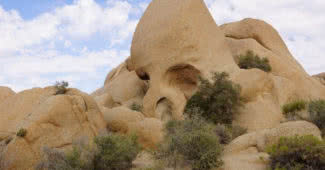The far-distant landscapes we know of, such as the Martian volcanoes, the red spot on Jupiter, and the Moon’s rocky surface, always amaze us with their unusual shapes. However, one does not have to be an astronaut to enjoy such otherworldly places, as our blue planet boasts some of the most peculiar and beautiful landscapes.
The following are the top 10 most extraordinary and stunning landscapes in the world. All these landscapes owe their unique appearances to natural erosion that has taken millions of years. Most of them keep changing their structures over time.
10Chocolate Hills, Philippines
At the end of the dry season, the hills change from green to chocolate brown, which is how they got their name. The height of each hill ranges from 30 to 120 meters. Researchers have discovered that algae, halobacteria, and other microbes cause the unique color of the hills.
9Mono Lake, California
Mono Lake has no outlets to seas and is famous for producing large deposits of alkaline particles. In addition to its unique geological features, the water of Mono Lake also exhibits some mysterious properties. Its thick and oily water is slippery to the touch and contains high concentrations of salt and baking soda. The lake is also home to brine shrimp, which attract millions of migratory birds every year.
Top 10 most amazing rock formations in United States
8Giant’s Causeway, Ireland
The Giant Causeway is a natural formation located in County Antrim, Northern Ireland. It consists of around 40,000 hexagonal basalt columns formed from an ancient volcanic eruption about 60 million years ago. Although the causeway has been studied extensively, the unique shape of the columns remains a mystery. The Giant Causeway is a UNESCO World Heritage Site.
Not only is it beautiful, but it also provides a habitat for around 50 species of birds and many plants. The columns have varying heights and thicknesses, with the tallest reaching 40 feet. People have lived around the Giant Causeway since the 19th century, but it is now uninhabited. Despite this, it still attracts around 300,000 tourists every year.
7Spotted Lake, British Columbia
Located in British Columbia, Canada, Spotted Lake is known for being the most mineralized lake in the world. Due to the high concentration of different chemical components, it features various spots of different colors that become more visible during the dry season. Each spot has a unique composition of chemical elements, with magnesium sulfate being the most predominant mineral.
The salts and minerals collected in the lake from the surrounding hills and their concentration determine the colors of the spots, which can range from white and pale yellow to blue, and green. The Okanagan tribe considered Spotted Lake a sacred place and used its water to cure some diseases. Interestingly, the colors of the spots change throughout the day.
6Midway Geyser Basin, Wyoming
The multicolored layers of the geyser are a result of different species of thermophile bacteria that live in progressively cooler water. Additionally, the chlorophyll and water temperature create colored spots across the geyser. The center spot of the geyser always appears blue due to the high heat, while other spots appear in orange, red, and white colors.
5Fly Geysers, Nevada
Fly Geysers, located in Gerlach, Nevada, is one of the world’s breathtaking geologic wonders. Unlike many natural geysers formed millions of years ago, this is an accidental creation as part of human interventions. In 1964, a geothermal energy exploring team started drilling to find its geothermal sources. But, that work was an unfinished one.
The dissolved minerals in that area accumulated and erupted water up to a height of 5 feet. With this, water erupted from deep red and blue-colored mounts, causing the formation of this geyser due to the action of thermophilic algae. Apart from its visual appeal, all these geothermal processes, microbial life, and mineral deposition have always made this a subject of scientific study.
4Hillier Lake, Australia
Lake Hillier is a stunning water body located on the Recherche archipelago of Western Australia. Unlike other lakes, Lake Hillier has permanent pink-colored water, a unique attraction for air passengers as it is situated beside the blue ocean. Surrounded by a dense forest of paperbark and eucalyptus trees, its diameter spans 600 meters.
The coloration of Lake Hillier remains a mystery, and scientists do not fully understand it, although most suspect it involves the Dunaliella salina microalgae as they produce carotenoids, a pigment found in carrots. Recent research suggests that the lake’s unusual pink color results from a combined effect of salt-loving bacteria and algae. These organisms can thrive in extreme environments.
3Kilauea Volcano, Hawaii
While most of Kilauea’s eruptions are nonexplosive and contained within Halemaumau, one of the island’s most destructive eruptions happened in 1955. As the name suggests, Kilauea, which means “Much Spreading” in Hawaiian, is a long dome created from lava eruptions. The volcano encompasses Halemaumau Crater and is the most active vent, with a recorded total of 61 eruptions.
2Salar De Uyuni, Bolivia
When this area is covered by water, it becomes the largest natural mirror on Earth, reflecting the sky, clouds, and everything above the surface. This flat, stable surface remains unchanged over time, and NASA takes advantage of this property to calibrate the satellites. Beneath the salt depositions, there are vast reservoirs of lithium-rich brine, contributing approximately 70% of the world’s lithium reserves.
Related Articles
1Zhangjiajie National Park, China
You can find rare white-flowered trees that first appeared on Earth 205 million years ago and around 100 different types of vertebrates living within the park’s boundaries. The Chinese Giant Salamander, one of the most famous endangered residents, inhabits pools and caves throughout the forest and is strictly protected by the Chinese government.




